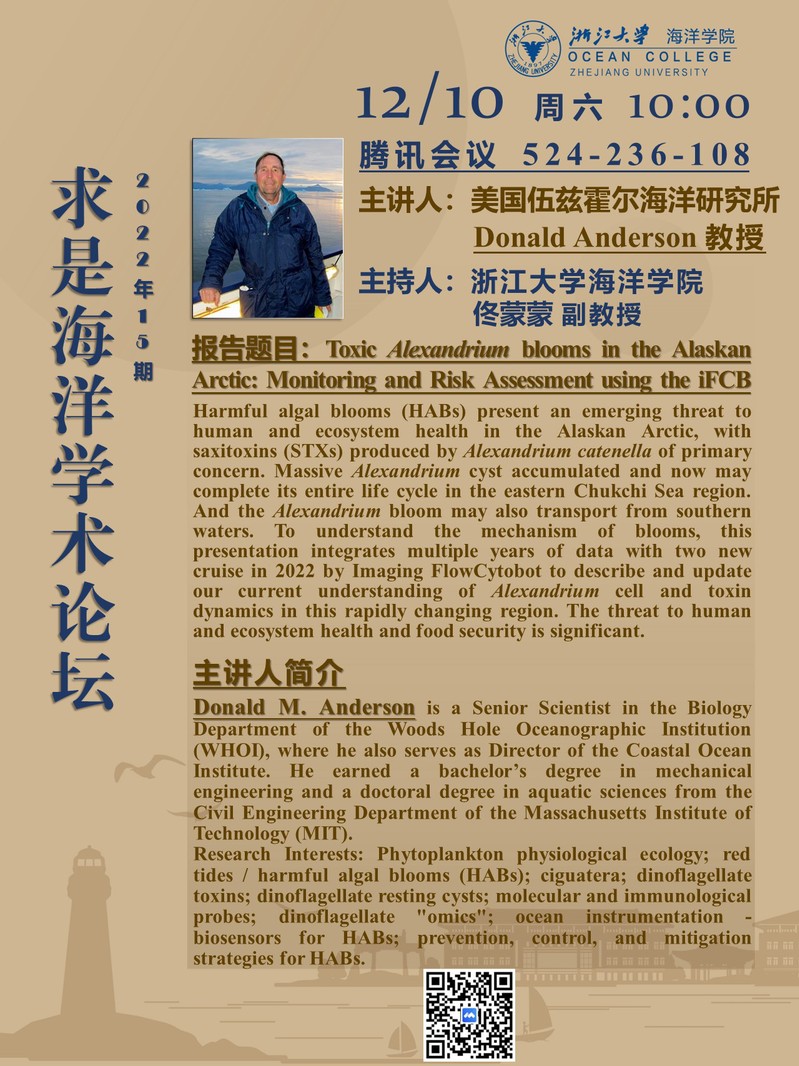求是海洋学术论坛2022年15期——Toxic Alexandrium blooms in the Alaskan Arctic: Monitoring and Risk Assessment using the iFCB

一、时间:2022年12月10日(周六)上午10:00
二、方式:腾讯会议524-236-108
三、主讲人:美国伍兹霍尔海洋研究所 Donald Anderson教授
四、报告题目:Toxic Alexandrium blooms in the Alaskan Arctic: Monitoring and Risk Assessment using the iFCB (北极有毒亚历山大藻赤潮的在线监测和风险评估)
报告摘要:
Harmful algal blooms (HABs) present an emerging threat to human and ecosystem health in the Alaskan Arctic, with saxitoxins (STXs) produced by Alexandrium catenella of primary concern. Past field studies documented massive Alexandrium cyst accumulation zones (cystbeds) in the eastern Chukchi Sea region. Additional data suggest that Alexandrium can now complete its entire life cycle in the region, where formerly it was too cold. This new mechanism for in situ bloom initiation and development augments episodic transport of established bloom populations of Alexandrium from southern waters. These two mechanisms of bloom development were investigated during two successive HAB cruises in 2022. A critical tool in this survey was the Imaging FlowCytobot that processed samples continuously, giving unprecedented "situational awareness" of the bloom that was encountered, and allowing public health risk advisories to be issued to local communities. This presentation integrates multiple years of data with the new cruise observations to describe and update our current understanding of Alexandrium cell and toxin dynamics in this rapidly changing region. The threat to human and ecosystem health and food security is significant, as many coastal communities rely on harvesting of seabirds, marine mammals, and other potential vectors of STXs for their nutritional, cultural, and economic well-being.
主讲人简介:
Donald M. Anderson is a Senior Scientist in the Biology Department of the Woods Hole Oceanographic Institution (WHOI), where he also serves as Director of the Coastal Ocean Institute. He earned a bachelor's degree in mechanical engineering and a doctoral degree in aquatic sciences from the Civil Engineering Department of the Massachusetts Institute of Technology (MIT). Anderson became interested in red tides and HABs as an MIT graduate student when a massive red tide devastated the New England coast. His work investigating chemical factors regulating Alexandrium blooms led to discoveries of a cyst stage and other biological processes that became his research focus. Since then, his research program has expanded and now ranges from molecular and cellular studies of toxin genetics to large-scale studies of the oceanography and ecology of algal blooms. He is actively involved in the organization and implementation of national and international programs for research and training on HABs.




